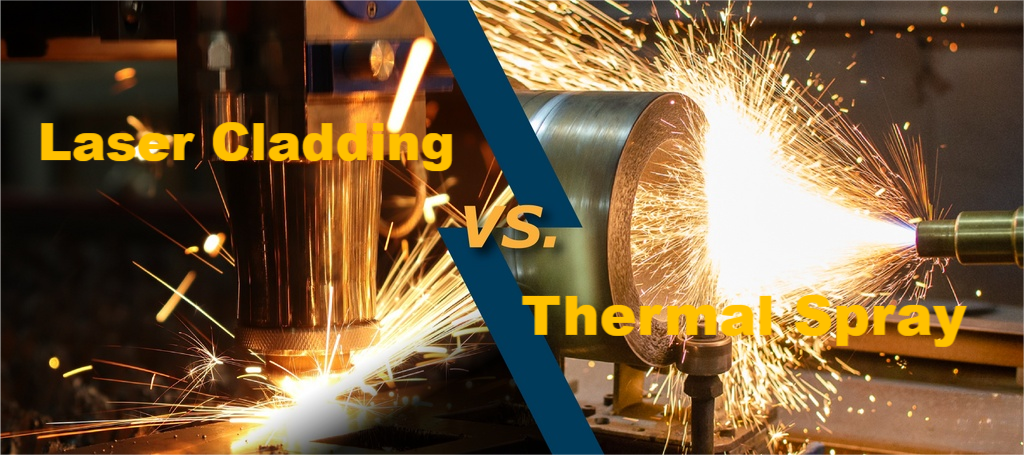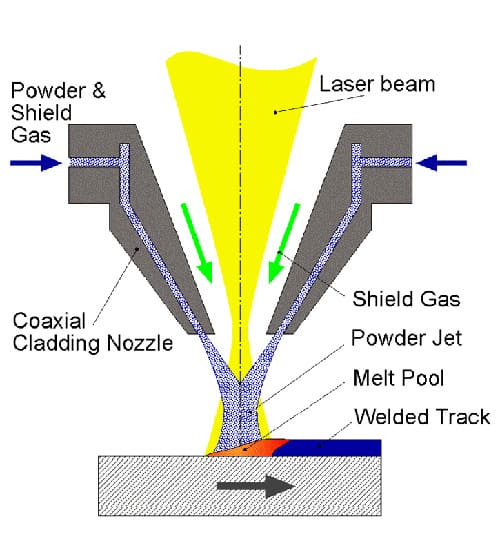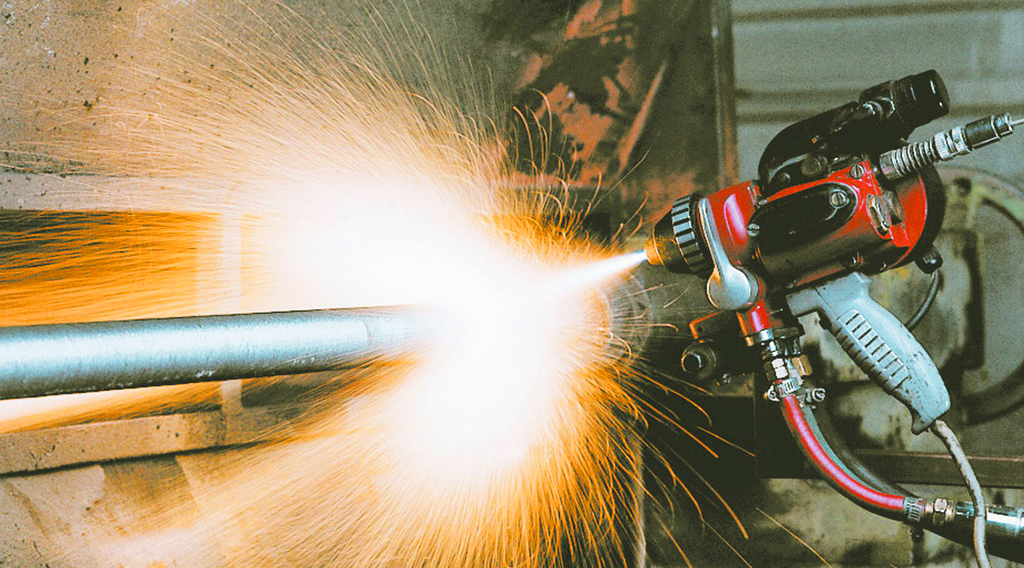Laser cladding and thermal spray are two methods that improve the surface characteristics of a substrate. Both procedures entail depositing a protective or functional layer over the substrate, but they differ significantly. Let’s take a deeper look at laser cladding and thermal spray and compare their benefits and drawbacks.you can find the answer to almost any question in minutes.


What Is Laser Cladding?
Laser cladding is a method that melts and deposits material onto the surface of a substrate using a laser beam. The laser energy also gently melts the substrate, allowing the deposited material to merge and allow. After cooling, the molten material creates a metallurgically bonded layer on the substrate. Laser cladding can deposit almost any metallic substance that can be welded.


Advantages Of Laser Cladding
- Input of Low Heat: Laser cladding generates a very localized heat input, which reduces the danger of substrate deformation and thermal damage.
- Bond Metallurgical: The metallurgical bond created at very low temperatures is the most significant advantage of laser cladding. Because laser cladding employs metallurgical bonding, the coatings have little to no porosity, leading in excellent long-term corrosion resistance.
- Exact Deposition: Using a high-accuracy CNC machine tool, laser cladding produces a tiny, controlled weld bead, allowing for highly accurate material deposition onto the substrate. This makes it excellent for repairing or customizing fragile components.
- Reduce the temperature:This metallurgical bond is achieved by laser cladding at a lower temperature than most other methods. It has a tiny heat affected zone, which is the area of the base metal where the characteristics have altered owing to high temperatures. The heat affected zone in laser cladding is approximately 0.03″ thick. This is useful if your part is susceptible to heat distortion.
- Cladding and alloying: Laser cladding can be used to develop novel metals or cladding materials that would be impossible to make using standard methods. Several metallic materials can be injected and melted at the same time.
- Repairability: Laser cladding can repair and restore damaged or worn components to their original state.
- One-Step Construction:When compared to other methods, laser cladding enables for thicker build up in a single pass. Overlapping passes combine to provide a high-quality surface. This, paired with low metal dilution, implies that post-process machining is negligible.
Disadvantages Of Laser Cladding
- Expensive equipment:Laser cladding equipment is quite costly and necessitates extensive operator training and expertise.
- Material Selection Is Limited:Laser cladding is generally limited to metals and alloys and is ineffective for depositing ceramics or polymers.
- Slow Procedure:Because laser cladding is a lengthy process, it is not appropriate for high-volume manufacturing runs.
- Process Restrictions:Laser cladding is mostly a robotic-controlled procedure. While this increases precision, it also reduces versatility. Not only is the system not portable, but it can also complicate bigger components.
Problems with Coating Thickness:Thick build up, like most advantages, has a disadvantage. Because laser cladding puts down so much in one pass, it might struggle with thin coatings. Cracking can also be caused by a rapid build rate.
What Is Thermal Spray?
Thermal spray is a procedure that involves spraying a stream of molten or heated material over the surface of a substrate. The deposited substance mechanically adheres to the roughened surface. As it cools and hardens, this substance produces a coating on the substrate. Thermal spraying is a flexible technique with several applications. It is frequently used to increase surface wear resistance, corrosion resistance, or electrical conductivity.


Advantages Of Thermal Spray
- High rates of deposition:Thermal spray has the ability to deposit material onto the substrate fast, making it suited for high-volume manufacturing runs.
- Extreme condition protection:Thermal spray coatings can protect against intense temperatures, chemicals, and abrasion.
- Flexibility:Thermal spray can be used on difficult-to-reach areas or unusually shaped surfaces.
- A diverse selection of materials:Thermal spray may be used to apply a range of materials, including laser cladding materials. To augment the coating qualities, other material alternatives can be employed. Thermal spray coatings can be used to provide dielectric, thermal barrier, and electrically conductive coatings in addition to wear and corrosion resistance. Arc Spray, a thermal spray method, may feed two distinct materials to create a designed alloy coating.
- Increases the life of components:Thermal spray coatings can considerably increase component life by protecting it against wear, corrosion, and other types of damage.
- Process Flexibility : Thermal spray may also be used in the field due of its adaptability. Thermal spray guns, unlike laser cladding, can be operated independently of robots and can generate excellent coatings with competent operators. The standard robotically controlled thermal spray setup can also handle complicated designs without substantial buildup in corners and on edges.
Capabilities for Thin Coating:Thermal spray methods may lay down coatings as thin as 0.002″ and, in certain situations, much thinner. When precise coating thicknesses are required, the ability to spray in thin layers can also help in the production of coatings. By performing several, robotically controlled passes, thermal spray may also build up thicker coats.
Disadvantages Of Thermal Spray
- Operators with extensive training and experience are required:To create consistent, high-quality results, thermal spray demands a high degree of operator training and expertise.
- Substrate damage risk:If not correctly regulated, thermal spray can cause deformation and thermal damage to the substrate.
- Cost: Thermal spray equipment is relatively expensive, as is the procedure itself.
- Porosity and Oxide Presence : Thermal spray coatings have modest to high porosity depending on the method used. If some coating materials are not sprayed properly in extremely corrosive settings, this can be a long-term problem. Porosity decreases coating stress and cracking, but it also interferes with surface finish, strength, and microhardness. During the thermal spray process, oxides are injected, which can enhance hardness and wear resistance but can also cause corrosion, strength, and machinability difficulties.
Increased Operating Temperature : Spray and fuse thermal spray can achieve metallurgical bonding, although at a greater temperature than laser cladding, between 1,900°F to 2,050°F. HVAF Spray, or High Velocity Air Fuel, has the lowest temperature of roughly 3,500°F and is mechanically bonded.
Laser Cladding VS Thermal Spray:A Quick Comparison
Wear and corrosion resistant coatings may be created using both thermal spray and laser cladding. Both have pros and cons. The easiest approach to pick is to determine exactly what you want in a surface repair or coating. If a metallurgical bond is required but temperature is a concern, laser cladding is the way to go. Thermal spray is a good option if you require a thin layer of material.
If your coating must perform functions other than wear and corrosion protection, you should investigate the many coating materials available with thermal spray.
| Arc Welding | Thermal Spray | Hard-Chrome Plating | Laser Cladding | |
|---|---|---|---|---|
| Heat Input | High | Low | N/A (chemical process) | Low |
| Dilution Rate | 10 – 40% | N/A(mechanical bonding) | No metallurgical bond | <5% |
| Hardness (HV) | Relatively Low | <1000 | 800 – 1000 | >1000 |
| Distortion | High | Low | N/A | Low |
| Heat Affected Zone | Large and wide | Low | N/A | Low |
| Quality | Less durable | Full of pores and less durable | Prone to chipping and delamination | Highly dense and Long life |
| Pre/Post Treatments | Many | Many | Many | Few |
| Automation | Difficult | Difficult | Difficult | Easy |
| Coat Thickness | >0.020” | 0.020” – 0.040” | 0.002” – 0.006” | >0.020” |
Laser Cladding VS Thermal Spray FAQs
Is laser cladding better than metal spray?
Different Needs, Different Processes
If you need a metallurgical bond and temperature is an issue, then laser cladding is the way to go. If you need a thin coating of material, then you should look to thermal spray.
What is the difference between PTA and laser cladding?
PTA welding is analogous to laser cladding. The key difference is that a plasma flame, rather than a more energy-dense laser beam, melts the substrate and additional material. When compared to laser cladding, the heating and cooling durations are slower, and the overall heat input is larger.
What are the advantages of laser cladding?
The benefits of laser cladding include higher quality coating material (including high bond strength and integrity) with less distortion and dilution, as well as improved surface quality. These benefits include the ability to precisely apply customised performance-enhancing material where it is needed.
What are the limitations of laser cladding?
Some disadvantages of laser cladding include:
- Initial equipment costs a lot of money.
- Deposition rates are low in comparison to other processes.
- The substrate is subjected to thermal strains and deformation.
- There is a limited selection of acceptable materials.
- It is necessary to do complex setup and parameter tuning.
Is laser cladding expensive?
High Equipment Costs: Laser cladding equipment is relatively expensive and necessitates extensive operator training and expertise. Laser cladding is often only achievable with metals and alloys, and it is not appropriate for depositing ceramics or polymers.
What is the best laser for cladding?
Diode laser cladding can now produce high-quality cladding with minimal dilution, low porosity, and a smooth surface finish. Because of the minimal heat input, diode laser has the least distortion of all the processes in Table 1 in the welding section.
What is the maximum thickness of laser cladding?
0.3 to 3.0 mm
Laser cladding is an additive manufacturing method in which a laser beam melts powder or wire material and hardens it into layers. Perfect metallurgical bonding to substrates allows for layer thicknesses ranging from 0.3 to 3.0 mm.
Where is laser cladding used?
Laser cladding extends the life of equipment and machinery whose parts are subjected to corrosion, wear, or impact. For example, the construction equipment business uses this technology to boost wear resistance and maintain equipment in service for extended periods of time.
What is the cooling rate in laser cladding?
A laser-cladded bead with a non-equilibrium microstructure. The cooling rate in the laser clad bead was predicted to be in the 104 K/s region, which is significantly greater than traditional solidification rates of 102 K/s.
